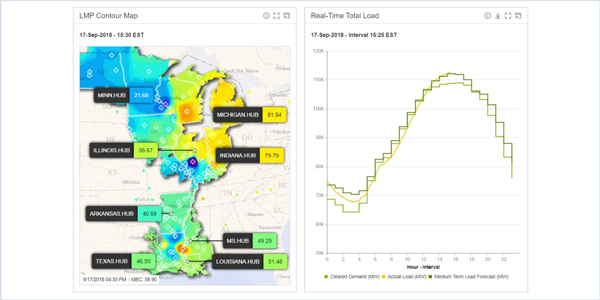By Amanda Durish Cook
MISO declared a maximum generation alert at noon Monday, saying tight reserve levels amid forced outages, hotter-than-expected temperatures and higher-than-forecasted load could prompt emergency procedures.
The action followed a string of notices and alerts over the weekend. On Saturday, the RTO ordered conservative operations for its entire footprint until midnight Wednesday.
Load hit 112,907 MW at Monday’s 4 p.m. peak. Real-time LMPs ranged from $22/MWh in Minnesota to $82/MWh in Michigan.
Last week, MISO said it had prepared for summertime conditions in September, in keeping with trends over the last three years. At the time, some stakeholders expressed doubt over the 19% probability the RTO gave itself of entering emergency procedures at least once this fall, with some saying the chance of an emergency was greater. (See MISO Sees Small Chance of Fall Emergency Procedures.)
Beginning on Saturday, MISO requested that generation and transmission owners defer or cancel all nonessential maintenance outages, asking that utilities reach out to coordinate returns to service.
In a Sept. 15 tweet, MISO said it was monitoring conditions in a hotter-than-usual MISO South, where Entergy issued public appeals to conserve energy on behalf of the RTO. Entergy said it was experiencing a “critical” shortage of electricity. MISO’s declaration of a maximum generation event requires members to make public conservation appeals and allows the RTO to make emergency power purchases to avoid load shedding.
“We appreciate our customers’ help in meeting power needs during this time by turning off all non-essential lighting, appliances and electronics as well as raising thermostats to 78 degrees. If possible, reduce use of water heaters, electric ovens, washing machines and dryers,” Entergy asked. The company eventually terminated the appeal for conservation at 6:30 p.m., hours earlier than MISO’s original prediction of 11 p.m.
19% Chance
At the Sept. 13 Market Subcommittee meeting, MISO officials said they had sufficient resources to cope with unseasonably warm conditions again this fall.
The RTO estimated a 19% chance that it would invoke emergency operating procedures to call on load-modifying resources (LMRs) this fall. Those resources are not obligated to respond when called upon after Sept. 1. MISO expects to have about 11.8 GW of available LMRs, based on availability forecasts provided by resource owners.
The RTO forecast a 110- to 120-GW peak load for September and said it prepared for loads more in line with summer conditions. The National Oceanic and Atmospheric Administration predicts above-normal fall temperatures for the MISO region.
“September generally aligns more closely with summer system conditions, at least for the last few years,” said Jeanna Furnish, MISO manager of outage coordination.
Furnish said MISO has so far this month experienced loads topping out at 114 GW, within about 1 GW of peak fall loads over the last three years.
For the last four years, MISO’s actual fall peak load has trended about 5 to 9 GW higher than load-serving entities have forecasted in 50/50 probability forecasts.
Furnish said MISO expects a 10- to 15-GW increase in planned outages from the end of September to the end of October, when load is projected to be lower. Navigating the outages will be “challenging, but manageable,” similar to the RTO’s experience in recent years.
After some stakeholders expressed confusion over the 19% statistic, MISO Executive Director of Market Development Jeff Bladen clarified that the RTO is not saying it will spend 20% of the fall in emergency operating procedures.
“There’s a 20% chance that we will go into emergency operating procedures at least once this fall,” he explained.
Some stakeholders wondered if MISO’s prediction was optimistic. Minnesota Public Utilities Commission staff member Hwikwon Ham pointed out NOAA predictions of a 40 to 60% chance of a major storm forming in the Gulf of Mexico last week.
During the meeting, stakeholders also received an emailed capacity advisory notice for a possible shortage on Sept. 17 owing to outages and residual weather conditions from Hurricane Florence. MISO rolled out the new notification system in August for situations when its all-in capacity is forecast to be less than 5% above operating needs. (See “New Notification System,” MISO Moving to Combat Shifting Resource Availability.)


